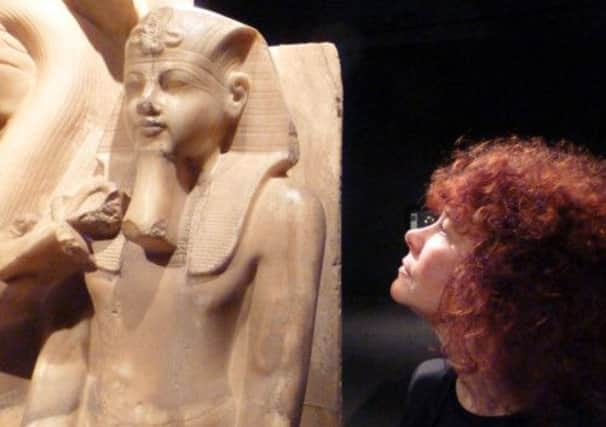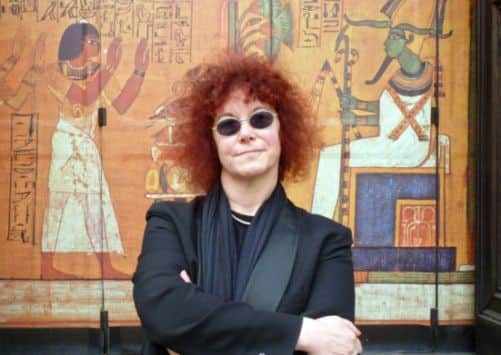Life, love and death in land of the pharaohs


WE know all about the Greeks and Romans from our school days, but when it comes to the Ancient Egyptians our knowledge tends to be a little more hazy.
Yes, we can conjure up images of Cleopatra, King Tutankhamun and the pyramids, but beyond this the land of the pharaohs has remained a mystery to most people.
Advertisement
Hide AdAdvertisement
Hide AdIt’s something that Barnsley-born historian and Egyptologist Dr Joann Fletcher hopes to change with her new two-part documentary Ancient Egypt: Life & Death In The Valley Of The Kings, which goes out on BBC Two next week. The Valley of the Kings is the burial place of some of Egypt’s most famous pharaohs, but it isn’t the lives of these kings, rather the ordinary people they ruled, that she’s interested in here.


Dr Fletcher, an honorary research fellow at York University, sheds light on the real lives of two ordinary Egyptians, a husband and wife from the tomb-builder’s town of Deir el-Medina who lived to serve their royal masters. By walking in their footsteps she provides an insight into what life was like 3,500 years ago, reimagining how people lived and the colours, sounds and smells they experienced.
She focuses on the lives of chief architect Kha and his wife, Meryt, who lived around 1400 BC. “It’s a bit of a departure for me because normally I’m studying the high and mighty, but with this I’m looking at ordinary people and specifically one married couple,” she explains.
During her forensic study she reads Egyptian love poems, discovers how Egyptians travelled to work, looks at how tombs were built and even gets an insight into Egyptian interior design. She also gains access to the rarely seen final resting place of Amenhotep III in the Valley of the Kings.
Advertisement
Hide AdAdvertisement
Hide AdIt’s thought that Kha was the man behind the mausoleums of three of ancient Egypt’s pharaohs as well as designing his and his wife’s final resting place. The reason so much is known about the pair is their mummified tombs were discovered in 1906 by a team of Italian archaeologists. Unlike many others that had been robbed or damaged theirs had remained hidden and intact with more than 500 items discovered in the burial chamber.
These, along with the couple’s mummified corpses, are now housed at the Egyptian Museum in Turin, which Dr Fletcher visited before travelling to Luxor, home to many of Ancient Egypt’s most historic sites.
She was granted special access by the Egyptian authorities to the tombs which hadn’t been seen since in more than a century. “It was amazing because I got to see the tomb of my favourite pharaoh Amenhotep III, who was Tutankhamun’s grandfather.”
However, it was Kha and his wife who were the main focus of her attention. “They were an intriguing couple and we found out how they lived and what they did on a day-to-day basis. We went to the village where Kha and Meryt lived for part of their life and I got a real feel for the place.”
Advertisement
Hide AdAdvertisement
Hide AdShe found entering their mausoleum an emotional experience. “They had the most amazing tombs and to think that the guy who’s mummy we’d been studying was responsible for the layout and design was amazing, I have so much admiration for him.
“I wanted to remain professional and composed and wax lyrical about how brilliant the Egyptian architecture was but I did have to dab my eyes a few times because it was just so beautiful.”
Thanks to CT scans they know that Kha outlasted his wife and lived until he was at least in his 60s. “The average life expectancy was about 35 to 40, so he lived to a ripe old age and lived through the reign of at least three kings.”
As well as tracing Kha’s footsteps through the Valley of the Kings Dr Fletcher walks though the village where he lived, which is part of the tourist trail, seeing where he and his family ate and slept. “We know that they made packed lunches and that bread and beer were Egyptian staples,” she says.
Advertisement
Hide AdAdvertisement
Hide AdDr Fletcher is also able to identify the funeral meal that was buried with him. “There were loaves of bread of all different shapes, like barm cakes some of which were shaped like animals, and these would have been laid out on the table.
“We recreated this bread using a mud brick oven similar to what they would have used and we were able to relive this funeral meal which also included preserved fish, bowls of grapes and duck.”
The Ancient Egyptians, she says, were very practical. “People wore black eye make-up, both men and women, but it wasn’t for vanity there was a practical purpose. They used it as a sun block and workmen used it to reduce the glare and if it was mixed with medicinal ingredients it could be used to ward off flies. They may have looked like members of the rock band Kiss but there was a reason for it.”
Dr Fletcher has been studying Egyptology pretty much her entire adult life, although her fascination with this ancient world began when she was just six years old. “A Tutankhamun exhibition came to the British Museum and that was it. I had posters of Tutankhamun all over my room, I was totally obsessed and when my mother said you could actually be an Egyptologist, I didn’t want to be anything else.”
Advertisement
Hide AdAdvertisement
Hide AdAfter studying Ancient History and Egyptology at University College London, she completed a PhD at Manchester University and has since written several books, including The Search for Nefertiti, which caused a stir when it was published nine years ago because of her claims that she had identified the mummified remains of the famous Egyptian queen through a fragment of a wig. She has also made regular TV appearances and is pleased that female historians, such as Mary Beard and Alice Roberts, have become familiar faces to viewers. “It’s great because it means more girls will look at people like this and think ‘I could do that’ and it shows that this is open to everyone – even people from Barnsley,” she says, laughing.
She believes we can learn from the Ancient Egyptians. “The Greeks and the Romans were European and we believed what they told us, whereas Egypt seemed too far away in space and time and the people seemed a bit too strange and exotic.
“But in many ways they were a lot like us. Sure, they had some weird ideas but they believed they would be reunited on the other side with their loved ones and we can relate to these desires.
“They even wrote letters to the dead. There’s one letter written by a women to her husband telling him that she needs him and asking why he’s not there, so even when he’s dead she’s still bending his ear.”
Advertisement
Hide AdAdvertisement
Hide AdThis might sound a bit wacky but Dr Fletcher suggests their attitudes to death were perhaps healthier than ours. “For Egyptians life and death weren’t so dramatically apart. They had a closer, more formal relationship with dead relatives than we have. I think they had a rather more healthy attitude than ours which is if you don’t talk about it then it won’t happen. They saw life as a dress rehearsal and that heaven was like earth only for eternity, which is why the preparation for the afterlife was so important,” she says.
“They seduce you in so many ways. The popular image is of these people who walked sideways and did strange things, but once you begin to understand what they were about, how they lived and loved, then they start to make more sense.
“They had similar likes and dislikes, they enjoyed eating nice food and they had quite high literacy levels. When you read their notes, their love letters and laundry lists they become more human, rather than these strange creatures from another planet that people often mistake them for.”
She believes the Ancient Egyptians had an upbeat view of life and hopes her documentary makes them real to viewers. “I want them to be seen as people you could have a laugh and a drink with. Once you get past all their goddesses and beliefs you see that all they really wanted was a supply of beer and to be with their loved ones for eternity. What’s not to like?”
Advertisement
Hide AdAdvertisement
Hide AdAncient Egypt: Life and Death In The Valley Of The Kings starts March 15, 9pm on BBC2.
Life & death in ancient egypt
Around 5,000 years ago and for the following 30 centuries, Egypt was the foremost nation in the Mediterranean world. Then, in 332 BC, the arrival of Alexander the Great heralded the end of the Egyptian way of life.
The Ancient Egyptians were experienced in dissecting corpses because, believing that their souls needed an earthly body, they preserved their dead as mummies.
Mummification is inextricably linked with the culture of ancient Egypt although the word “mummy” is generally believed to derive from a Persian word, mummiya, meaning ‘bitumen’, which is used to describe the blackened state of ancient Egyptian bodies.